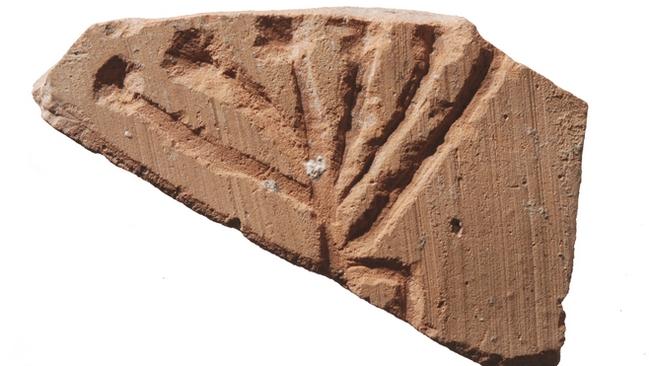Israeli archaeologists call for public help in deciphering Temple Mount mark
THE markings on this ancient pot fragment could be of enormous significance for the history of Jerusalem’s Temple Mount — if only we could figure out what it is.

THIS ancient pot fragment is just 2cm wide. But the mark it contains could be of enormous significance for the history of Jerusalem’s Temple Mount — if only we could figure out what it is.
The Temple Mount Sifting project — tasked with scratching through 400 truckloads of rubble removed from the contentious religious site by Islamic authorities in 1999 — has been seeking traces of the biblical First Temple.
They think they may have found one.
“Want to help decipher an archaeological mystery?” a blog linked to the project asks.
“A very interesting incised design appears on an ancient potsherd found in the sifting of the soil from the Temple Mount.
“Is it the Temple Menorah? Some kind of floral design? Something else? How can we date this potsherd? When was the incision done? By whom and for what purpose?
“If it is a menorah, what can we learn from this artefact?
“We welcome your suggestions …”

ANCIENT ICONS
A menorah is a distinctive seven-branched candle holder used in the ancient Jewish Holy of Holies, and has long since become a symbol of the religion.
One is said to have lit the holy Tabernacle protecting the Ark of the Covenant during the Jewish exile from Egypt. They became a feature of the First Temple in Jerusalem.
The catch is: The pot shard image appears to only show six arms.
The First Temple is a place dear to the heart of the Jewish religion: It was said to have been built by King Solomon to house the Ark of the Covenant. Scholars state this was some time around 832BC.
Biblical references state it was destroyed by the Babylonian king Nebuchadnezzar II. Some have dated this event to 587BC.
But no direct archaeological evidence of this iconic religious structure has ever been uncovered.
In part, this is because the Second Temple was erected on the same site, before it too was destroyed by the Romans in 70AD.
Temple Mount, or Mount Zion, currently houses the Dome of the Rock (built in 691AD) and Al Aqsa mosque (705AD). Both sites are of immense significance to the Islamic faith.

OUT OF THE RUBBLE
The sifting project is making an opportunity out of an archaeological disaster.
In 1999 the Islamic Trust responsible for the maintenance of the Temple Mount site bulldozed rubble from the historic site, hauling 400 truckloads of the detritus to a dump in a valley outside the Old City.
After some 15 years of sifting through the dust and rock, the project has found scant evidence of the First Temple era.
These include a few stone weights and an ancient Hebrew seal bearing a mark attributed to the Judaean king Hezekiah.
Several other objects apparently linked to the temple were only discovered by academics after they had hit the antiquities market. Therefore their authenticity remain suspect.
The challenge to identify the mark on the pot shard coincides with the end of a crowd funding campaign to continue the Temple Mount Sifting Project.



